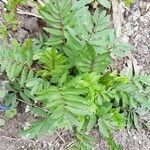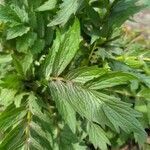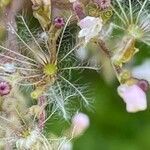Fibrous-rooted perennial 5–15 dm from a short rhizome; stems hairy at least at the nodes; basal and cauline lvs similar, pinnately divided into 11–21 lanceolate, dentate segments; petioles of the upper lvs progressively shorter; infl large and open, the lower branches often remote from the upper; cor obconic, the tube 4 mm, the lobes 1 mm; fr lance-oblong, 3–5 mm, glabrous; 2n=14, 28, 56. Native of Eurasia, escaped from cult. here and there in our range. May–Aug.
A small shrub. It keeps growing from year to year. It grows 1.2-1.8 m high. It spreads 40-80 cm wide. The stem is erect, hollow, hairy and angular. The leaves are in pairs, united at the base and deeply divided. There are 7-20 sword shaped leaflets. These are serrated around the edge. The flowers are in heads 5-10 cm wide. They are pinkish white and have a musk scent.












